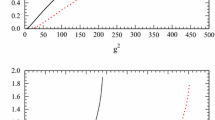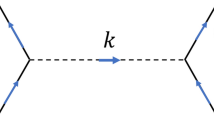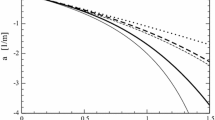Abstract
The Bethe-Salpeter (BS) equation in the ladder approximation is studied within a fermion theory: two fermion fields (constituents) with mass m interacting via an exchange of a scalar field with mass μ. The BS equation can be written in the form of an integral equation in the configuration Euclidean x-space with the symmetric kernel K for which Tr K 2 = ∞ due to the singular character of the fermion propagator. This kernel is represented in the form K = K 0 + K I . The operator K 0 with Tr K 0 2 = ∞ is of the “fall at the center” potential type and describes a continuous spectrum only. Besides the presence of this operator leads to a restriction on the value of the coupling constant. The kernel K I with Tr K I 2 < ∞ is responsible for bound fermion-fermion states.
Our approach is that the eigenvalue problem of the equation \(\Lambda\Psi = g^2(K_0 + K_I)\Psi \qquad {\rm with}\qquad \Lambda = 1\) can be rewritten in the form \(\Phi={\frac {1}{\sqrt{\Lambda-g^2 K_0}}} g^2 K_I {\frac {1} {\sqrt{\Lambda-g^2K_0}}}\Phi.\) The kernel of the last equation is finite for g 2 < g c 2 and the variational procedure of calculations of eigenvalues and eigenfunctions can be applied.
The quantum pseudoscalar and scalar mesodynamics is considered. The binding energy of the state 1+ (deuteron) as a function of the coupling constant is calculated in the framework of the procedure formulated above. It is shown that this bound state is absent in the pseudoscalar mesodynamics and does exist in the scalar mesodynamics. A comparison with the non-relativistic Schrödinger picture is made.
Similar content being viewed by others
References
Wick GC (1954) Phys Rev 96:1124; Cutkosky RE (1954) Phys Rev 96:1135
C Itzykson J-B Zuber (1980) Quantum field theory McGraw-Hill New York
W Greiner J Reinhart (1992) Quantum electrodynamics Springer Berlin Heidelberg New York
Nakanishi N (1965) Phys Rev 138:B1182; (1969) Pr Theor Phys Suppl 43:1
SM Dorkin et al. (2006) Phys Part Nucl 37 867 Occurrence Handle10.1134/S1063779606060037
S Weinberg (1999) The quantum theory of fields NumberInSeries1 Cambridge University Press Cambridge
GE Brown AD Jackson (1976) The nucleon-nucleon interaction North-Holland New York
T Nieuwenhuis JA Tjon (1996) Few Body Syst 21 167 Occurrence Handle10.1007/s006010050046 Occurrence Handle1996FBS....21..167N
GV Efimov (2003) Few Body Syst 33 199 Occurrence Handle10.1007/s00601-003-0015-1 Occurrence Handle2003FBS....33..199E
Mandelstam S (1955) Proc Roy Soc A 233:248; (1956) Proc Roy Soc A 237:486; (1958) Phys Rev 112:1344
G Tiktopoulos (1965) J Math Phys 6 573 Occurrence Handle0127.19501 Occurrence Handle10.1063/1.1704308 Occurrence Handle1965JMP.....6..573T Occurrence Handle174315
JJ Kubis (1972) Phys Rev D 6 547 Occurrence Handle10.1103/PhysRevD.6.547 Occurrence Handle1972PhRvD...6..547K
K Kusaka AG Williams (1995) Phys Rev D 51 7026 Occurrence Handle10.1103/PhysRevD.51.7026 Occurrence Handle1995PhRvD..51.7026K
F Gross C Savkh J Tjon (2001) Phys Rev D 64 076008 Occurrence Handle10.1103/PhysRevD.64.076008 Occurrence Handle2001PhRvD..64g6008G
CJ Burden MA Pichowsky (2002) Few Body Syst 32 119 Occurrence Handle10.1007/s00601-002-0113-5 Occurrence Handle2002FBS....32..119B
J Praschifka RT Cahill CD Roberts (1989) Int J Mod Phys A 4 4929 Occurrence Handle10.1142/S0217751X89002090 Occurrence Handle1989IJMPA...4.4929P
RT Cahill J Praschifka CJ Burden (1989) Aust J Phys 42 161 Occurrence Handle1989AuJPh..42..161C
RT Cahill (1992) Nucl Phys A 543 63 Occurrence Handle10.1016/0375-9474(92)90411-C Occurrence Handle1992NuPhA.543...63C
H Kleinert (1976) Phys Lett B 62 429 Occurrence Handle10.1016/0370-2693(76)90676-6 Occurrence Handle1976PhLB...62..429K
T Kugo (1978) Phys Lett B 76 625 Occurrence Handle10.1016/0370-2693(78)90870-5 Occurrence Handle1978PhLB...76..625K
GV Efimov (2004) Phys Part Nucl 35 598
Author information
Authors and Affiliations
Additional information
Correspondence: G. V. Efimov, Bogoliubov Laboratory of Theoretical Physics, Joint Institute for Nuclear Research, 141980 Dubna, Russia
Rights and permissions
About this article
Cite this article
Efimov, G. The Bethe-Salpeter equation with fermions. Few-Body Systems 41, 157–184 (2007). https://doi.org/10.1007/s00601-007-0180-8
Received:
Accepted:
Published:
Issue Date:
DOI: https://doi.org/10.1007/s00601-007-0180-8




